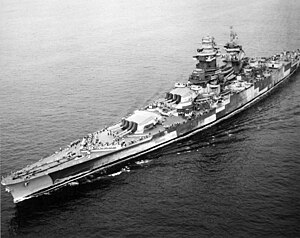
Back Ришельо (линеен кораб, 1939) Bulgarian Richelieu (1935) Czech Richelieu (Schiff, 1943) German Richelieu (1940) Spanish نبردناو ریشیلیو Persian FS Richelieu (1939) Finnish Richelieu (cuirassé de 1939) French Kapal tempur Prancis Richelieu ID Richelieu (nave da battaglia 1939) Italian リシュリュー (戦艦) Japanese
 Richelieu in September 1943 after her refit
| |
| History | |
|---|---|
| Name | Richelieu |
| Namesake | Cardinal de Richelieu |
| Builder | Arsenal de Brest |
| Laid down | 22 October 1935 |
| Launched | 17 January 1939 |
| Commissioned | 1 April 1940 |
| Decommissioned | 1967 |
| Stricken | 1968 |
| Fate | Broken up, 1968 |
| General characteristics Original configuration | |
| Class and type | Richelieu-class battleship |
| Displacement | |
| Length | 247.85 m (813 ft 2 in) |
| Beam | 33.08 m (108 ft 6 in) |
| Draft | Full load: 9.9 m (32 ft 6 in) |
| Installed power | |
| Propulsion | |
| Speed | 32 knots (59 km/h; 37 mph) |
| Range | 9,500 nautical miles (17,600 km; 10,900 mi) at 15 kn (28 km/h; 17 mph) |
| Complement | 1,569 |
| Armament |
|
| Armor |
|
| Aircraft carried | 4 × Loire 130 seaplanes |
| Aviation facilities | 2 × catapults |
| General characteristics 1943 refit | |
| Displacement |
|
| Draft | Full load: 10.68 m (35 ft) |
| Complement | 1,930 |
| Sensors and processing systems |
|
| Armament |
|
Richelieu was a French fast battleship, the lead ship of the Richelieu class. Built as a response to the Italian Littorio class, Richelieu and its sister ship Jean Bart were based on their immediate predecessors of the Dunkerque class: they used the same unconventional arrangement that grouped their main battery forward in two quadruple gun turrets. They were scaled up to accommodate a much more powerful main battery of eight 380 mm (15 in) guns (compared to the 330 mm (13 in) guns of the Dunkerques), with increased armor to protect them from guns of the same caliber.
Richelieu was laid down in 1935 and was launched in 1939, just before the outbreak of World War II in Europe. As war with Germany became increasingly likely, work on the ship was rushed to prepare her for commissioning in April 1940. Completed just days before the Germans won the Battle of France in June, Richelieu fled to Dakar in French West Africa to keep her under French control. There, she came under repeated British attacks that had been intended to either compel the battleship to join the Free French Naval Forces or sink her; these included during Operation Catapult in July 1940 and the Battle of Dakar in September.
Damaged in both attacks, the ship was slowly repaired before eventually being turned over to Free French control after the Allied invasion of North Africa in November 1942. After being sent to the United States for repairs and an extensive modernization, the ship served with the British Home Fleet in early 1944 before being deployed to the Eastern Fleet for operations against the Japanese in the Indian Ocean. These included several bombardment operations and in May 1945 she was present during the Battle of the Malacca Strait, though she was too far away to engage the Japanese force.
Richelieu was part of the force that liberated Singapore after the Japanese surrender in September, and she later operated in French Indochina as part of the initial effort to restore French colonial rule. Recalled to France in December 1945, she was repaired and modernized slightly in 1946. The ship saw relatively limited training in the immediate postwar years and, in 1952, she was removed from active service for use as a gunnery training ship. In 1956, she was placed in reserve and was thereafter used as a stationary training vessel and barracks ship until 1967, when the French Navy decided to discard her. She was sold for scrap in 1968, and broken up in Italy from 1968 to 1969.
© MMXXIII Rich X Search. We shall prevail. All rights reserved. Rich X Search